Examining Educational Theories and Techniques in Adult Learning
VerifiedAdded on 2020/05/11
|14
|3037
|64
AI Summary
This research essay delves into the application of various educational theories within adult learning contexts. By examining models like Kolb's Experiential Learning Theory, cognitive load considerations, and peer learning strategies, the paper aims to highlight how these frameworks can be integrated into lesson planning and instructional design for adults. Furthermore, it discusses the importance of flipped classroom techniques and self-directed learning in fostering an effective adult education environment. The essay draws on a range of scholarly sources to provide insights into optimizing teaching practices tailored to adult learners' unique needs and characteristics.
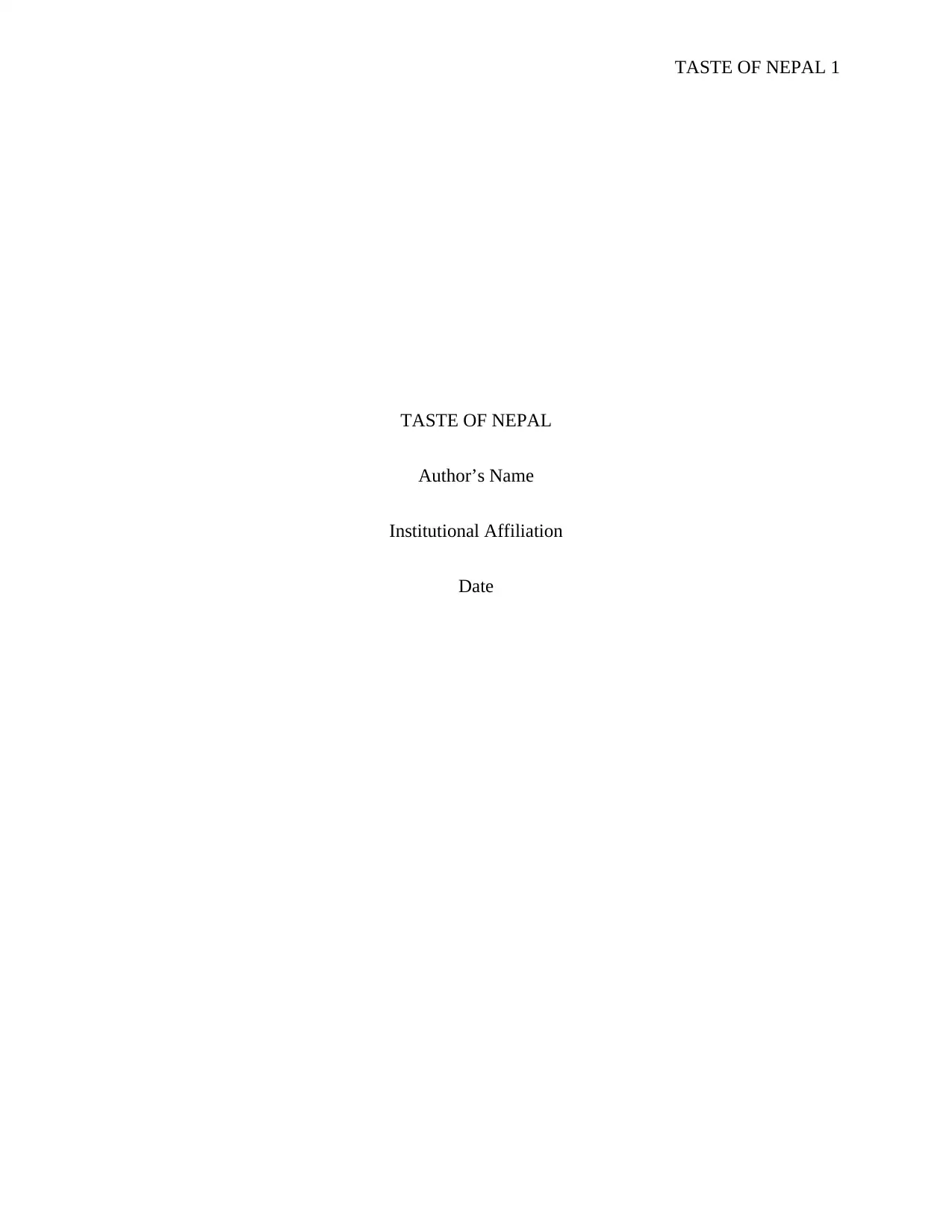
TASTE OF NEPAL 1
TASTE OF NEPAL
Author’s Name
Institutional Affiliation
Date
TASTE OF NEPAL
Author’s Name
Institutional Affiliation
Date
Paraphrase This Document
Need a fresh take? Get an instant paraphrase of this document with our AI Paraphraser
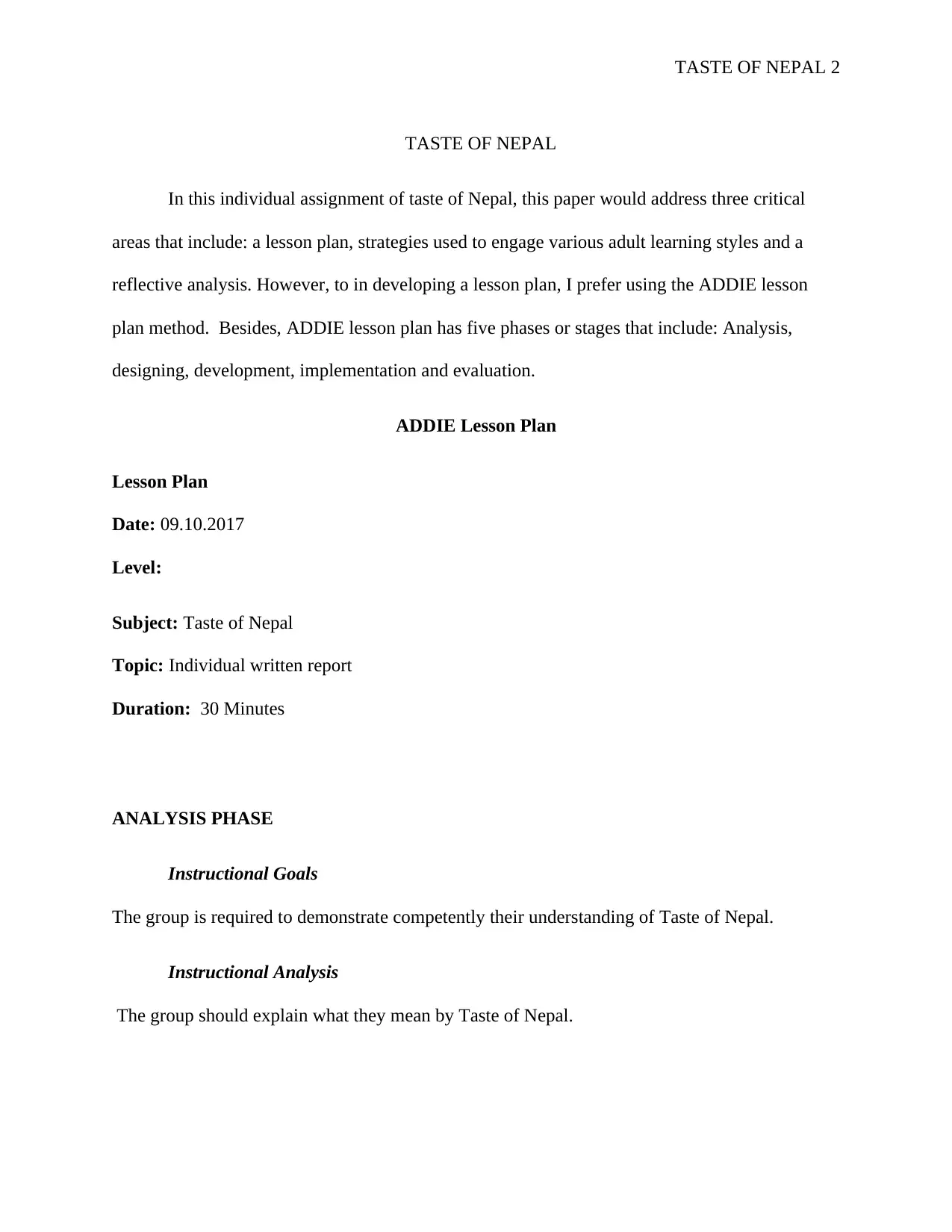
TASTE OF NEPAL 2
TASTE OF NEPAL
In this individual assignment of taste of Nepal, this paper would address three critical
areas that include: a lesson plan, strategies used to engage various adult learning styles and a
reflective analysis. However, to in developing a lesson plan, I prefer using the ADDIE lesson
plan method. Besides, ADDIE lesson plan has five phases or stages that include: Analysis,
designing, development, implementation and evaluation.
ADDIE Lesson Plan
Lesson Plan
Date: 09.10.2017
Level:
Subject: Taste of Nepal
Topic: Individual written report
Duration: 30 Minutes
ANALYSIS PHASE
Instructional Goals
The group is required to demonstrate competently their understanding of Taste of Nepal.
Instructional Analysis
The group should explain what they mean by Taste of Nepal.
TASTE OF NEPAL
In this individual assignment of taste of Nepal, this paper would address three critical
areas that include: a lesson plan, strategies used to engage various adult learning styles and a
reflective analysis. However, to in developing a lesson plan, I prefer using the ADDIE lesson
plan method. Besides, ADDIE lesson plan has five phases or stages that include: Analysis,
designing, development, implementation and evaluation.
ADDIE Lesson Plan
Lesson Plan
Date: 09.10.2017
Level:
Subject: Taste of Nepal
Topic: Individual written report
Duration: 30 Minutes
ANALYSIS PHASE
Instructional Goals
The group is required to demonstrate competently their understanding of Taste of Nepal.
Instructional Analysis
The group should explain what they mean by Taste of Nepal.
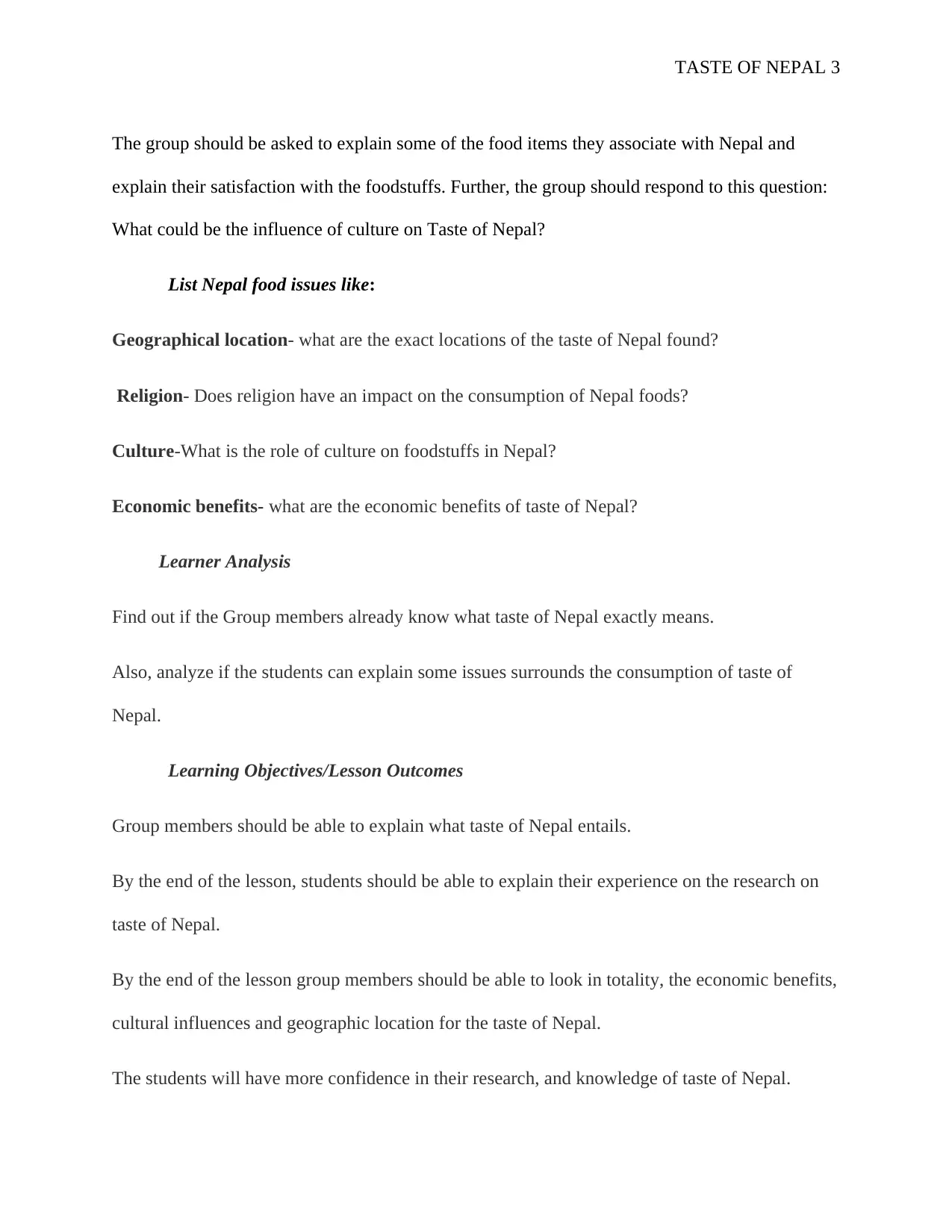
TASTE OF NEPAL 3
The group should be asked to explain some of the food items they associate with Nepal and
explain their satisfaction with the foodstuffs. Further, the group should respond to this question:
What could be the influence of culture on Taste of Nepal?
List Nepal food issues like:
Geographical location- what are the exact locations of the taste of Nepal found?
Religion- Does religion have an impact on the consumption of Nepal foods?
Culture-What is the role of culture on foodstuffs in Nepal?
Economic benefits- what are the economic benefits of taste of Nepal?
Learner Analysis
Find out if the Group members already know what taste of Nepal exactly means.
Also, analyze if the students can explain some issues surrounds the consumption of taste of
Nepal.
Learning Objectives/Lesson Outcomes
Group members should be able to explain what taste of Nepal entails.
By the end of the lesson, students should be able to explain their experience on the research on
taste of Nepal.
By the end of the lesson group members should be able to look in totality, the economic benefits,
cultural influences and geographic location for the taste of Nepal.
The students will have more confidence in their research, and knowledge of taste of Nepal.
The group should be asked to explain some of the food items they associate with Nepal and
explain their satisfaction with the foodstuffs. Further, the group should respond to this question:
What could be the influence of culture on Taste of Nepal?
List Nepal food issues like:
Geographical location- what are the exact locations of the taste of Nepal found?
Religion- Does religion have an impact on the consumption of Nepal foods?
Culture-What is the role of culture on foodstuffs in Nepal?
Economic benefits- what are the economic benefits of taste of Nepal?
Learner Analysis
Find out if the Group members already know what taste of Nepal exactly means.
Also, analyze if the students can explain some issues surrounds the consumption of taste of
Nepal.
Learning Objectives/Lesson Outcomes
Group members should be able to explain what taste of Nepal entails.
By the end of the lesson, students should be able to explain their experience on the research on
taste of Nepal.
By the end of the lesson group members should be able to look in totality, the economic benefits,
cultural influences and geographic location for the taste of Nepal.
The students will have more confidence in their research, and knowledge of taste of Nepal.
⊘ This is a preview!⊘
Do you want full access?
Subscribe today to unlock all pages.

Trusted by 1+ million students worldwide
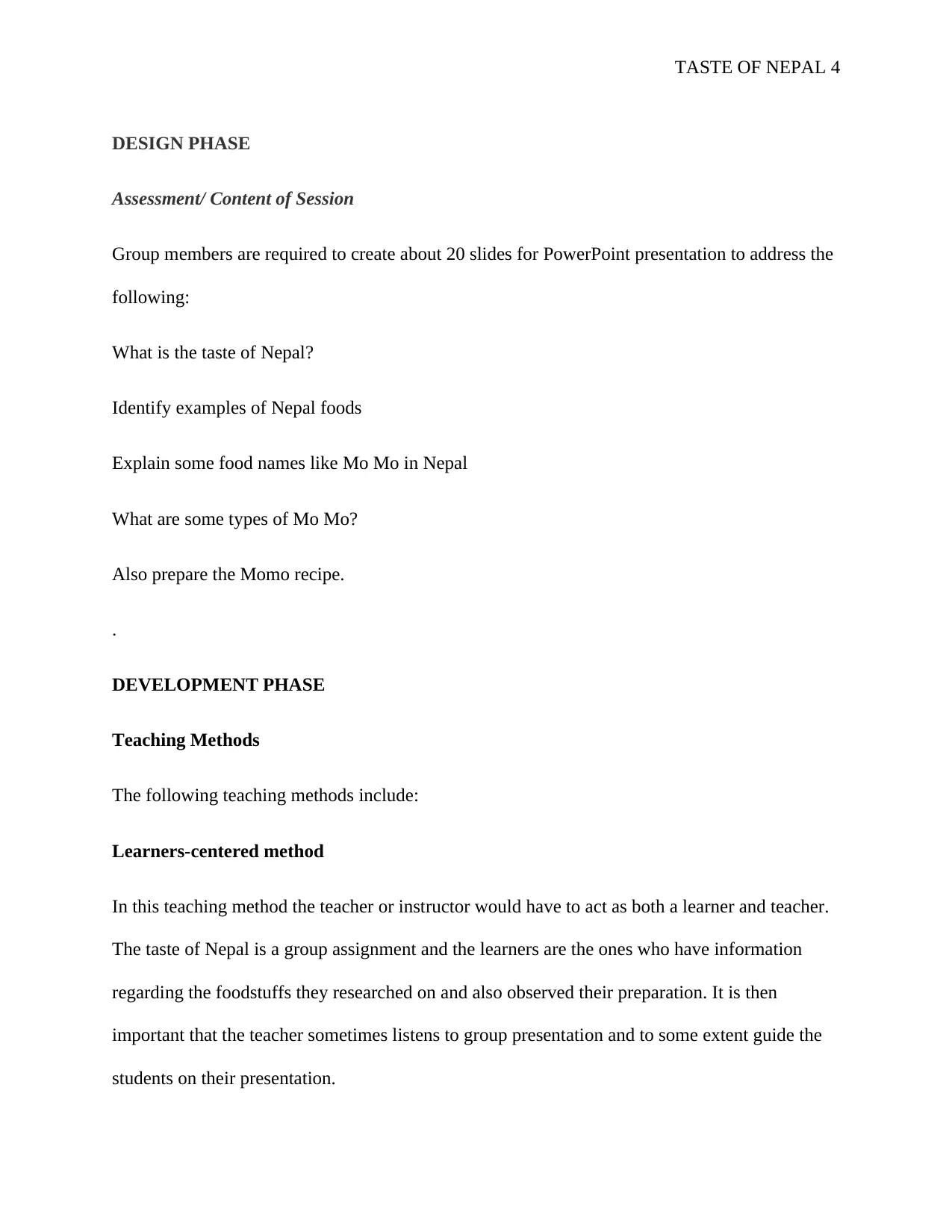
TASTE OF NEPAL 4
DESIGN PHASE
Assessment/ Content of Session
Group members are required to create about 20 slides for PowerPoint presentation to address the
following:
What is the taste of Nepal?
Identify examples of Nepal foods
Explain some food names like Mo Mo in Nepal
What are some types of Mo Mo?
Also prepare the Momo recipe.
.
DEVELOPMENT PHASE
Teaching Methods
The following teaching methods include:
Learners-centered method
In this teaching method the teacher or instructor would have to act as both a learner and teacher.
The taste of Nepal is a group assignment and the learners are the ones who have information
regarding the foodstuffs they researched on and also observed their preparation. It is then
important that the teacher sometimes listens to group presentation and to some extent guide the
students on their presentation.
DESIGN PHASE
Assessment/ Content of Session
Group members are required to create about 20 slides for PowerPoint presentation to address the
following:
What is the taste of Nepal?
Identify examples of Nepal foods
Explain some food names like Mo Mo in Nepal
What are some types of Mo Mo?
Also prepare the Momo recipe.
.
DEVELOPMENT PHASE
Teaching Methods
The following teaching methods include:
Learners-centered method
In this teaching method the teacher or instructor would have to act as both a learner and teacher.
The taste of Nepal is a group assignment and the learners are the ones who have information
regarding the foodstuffs they researched on and also observed their preparation. It is then
important that the teacher sometimes listens to group presentation and to some extent guide the
students on their presentation.
Paraphrase This Document
Need a fresh take? Get an instant paraphrase of this document with our AI Paraphraser
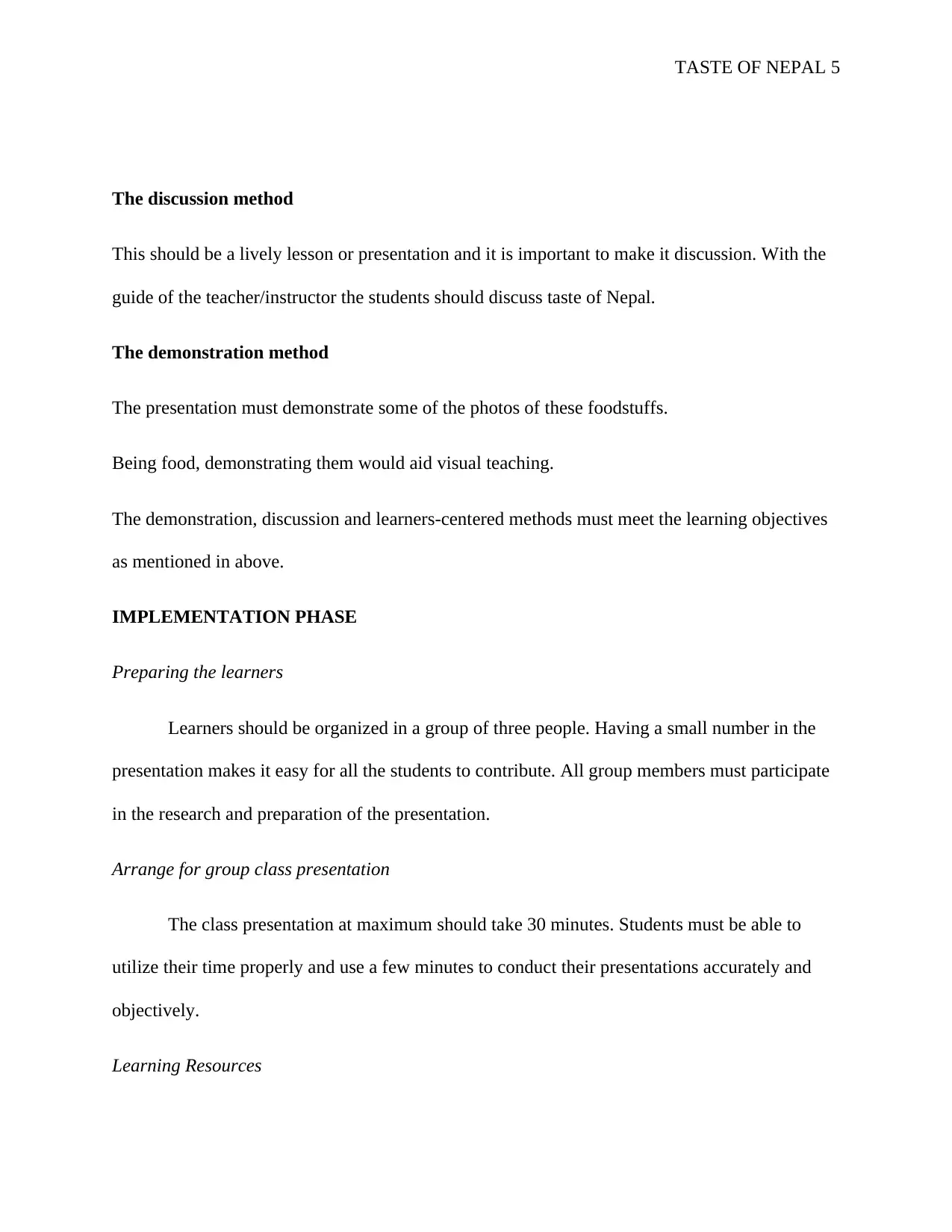
TASTE OF NEPAL 5
The discussion method
This should be a lively lesson or presentation and it is important to make it discussion. With the
guide of the teacher/instructor the students should discuss taste of Nepal.
The demonstration method
The presentation must demonstrate some of the photos of these foodstuffs.
Being food, demonstrating them would aid visual teaching.
The demonstration, discussion and learners-centered methods must meet the learning objectives
as mentioned in above.
IMPLEMENTATION PHASE
Preparing the learners
Learners should be organized in a group of three people. Having a small number in the
presentation makes it easy for all the students to contribute. All group members must participate
in the research and preparation of the presentation.
Arrange for group class presentation
The class presentation at maximum should take 30 minutes. Students must be able to
utilize their time properly and use a few minutes to conduct their presentations accurately and
objectively.
Learning Resources
The discussion method
This should be a lively lesson or presentation and it is important to make it discussion. With the
guide of the teacher/instructor the students should discuss taste of Nepal.
The demonstration method
The presentation must demonstrate some of the photos of these foodstuffs.
Being food, demonstrating them would aid visual teaching.
The demonstration, discussion and learners-centered methods must meet the learning objectives
as mentioned in above.
IMPLEMENTATION PHASE
Preparing the learners
Learners should be organized in a group of three people. Having a small number in the
presentation makes it easy for all the students to contribute. All group members must participate
in the research and preparation of the presentation.
Arrange for group class presentation
The class presentation at maximum should take 30 minutes. Students must be able to
utilize their time properly and use a few minutes to conduct their presentations accurately and
objectively.
Learning Resources
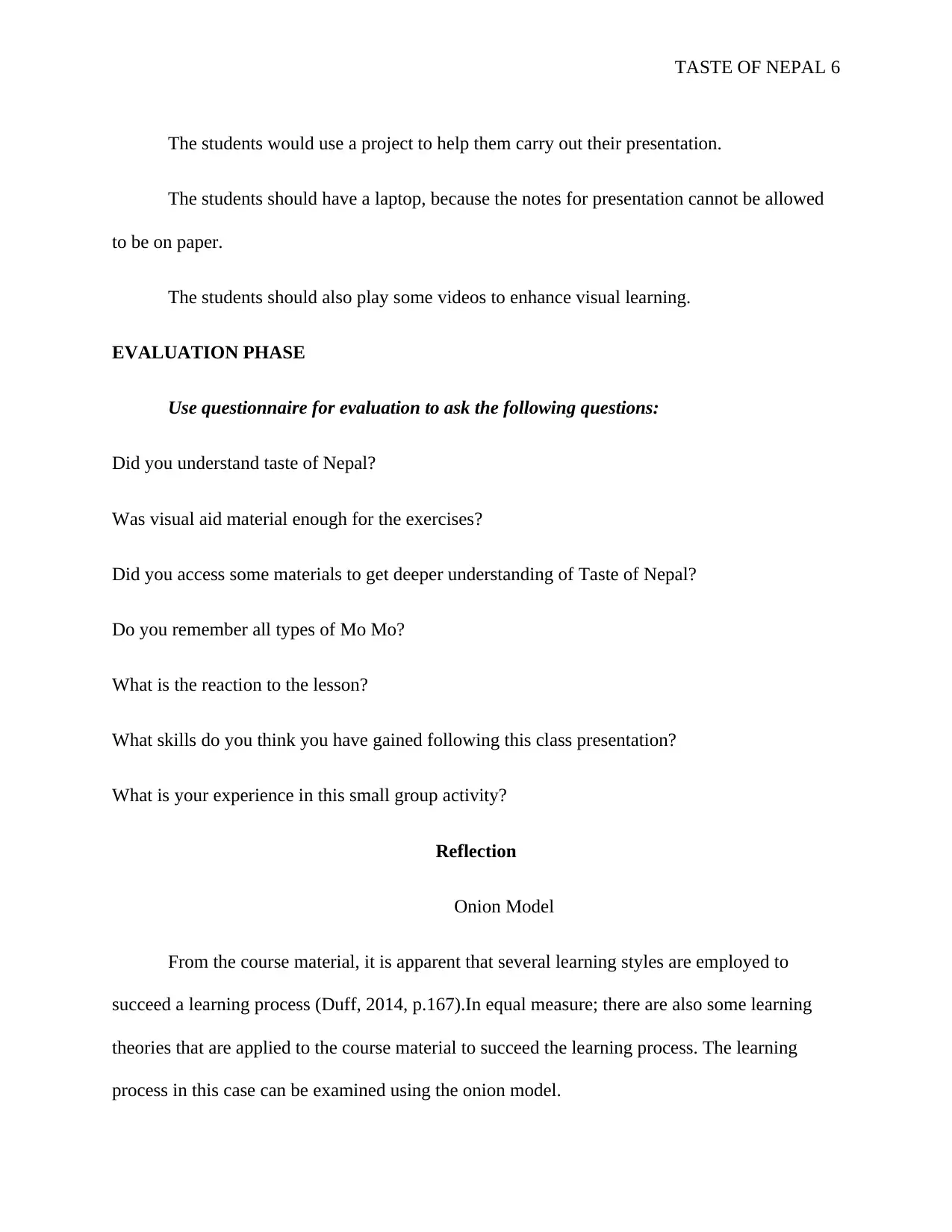
TASTE OF NEPAL 6
The students would use a project to help them carry out their presentation.
The students should have a laptop, because the notes for presentation cannot be allowed
to be on paper.
The students should also play some videos to enhance visual learning.
EVALUATION PHASE
Use questionnaire for evaluation to ask the following questions:
Did you understand taste of Nepal?
Was visual aid material enough for the exercises?
Did you access some materials to get deeper understanding of Taste of Nepal?
Do you remember all types of Mo Mo?
What is the reaction to the lesson?
What skills do you think you have gained following this class presentation?
What is your experience in this small group activity?
Reflection
Onion Model
From the course material, it is apparent that several learning styles are employed to
succeed a learning process (Duff, 2014, p.167).In equal measure; there are also some learning
theories that are applied to the course material to succeed the learning process. The learning
process in this case can be examined using the onion model.
The students would use a project to help them carry out their presentation.
The students should have a laptop, because the notes for presentation cannot be allowed
to be on paper.
The students should also play some videos to enhance visual learning.
EVALUATION PHASE
Use questionnaire for evaluation to ask the following questions:
Did you understand taste of Nepal?
Was visual aid material enough for the exercises?
Did you access some materials to get deeper understanding of Taste of Nepal?
Do you remember all types of Mo Mo?
What is the reaction to the lesson?
What skills do you think you have gained following this class presentation?
What is your experience in this small group activity?
Reflection
Onion Model
From the course material, it is apparent that several learning styles are employed to
succeed a learning process (Duff, 2014, p.167).In equal measure; there are also some learning
theories that are applied to the course material to succeed the learning process. The learning
process in this case can be examined using the onion model.
⊘ This is a preview!⊘
Do you want full access?
Subscribe today to unlock all pages.

Trusted by 1+ million students worldwide
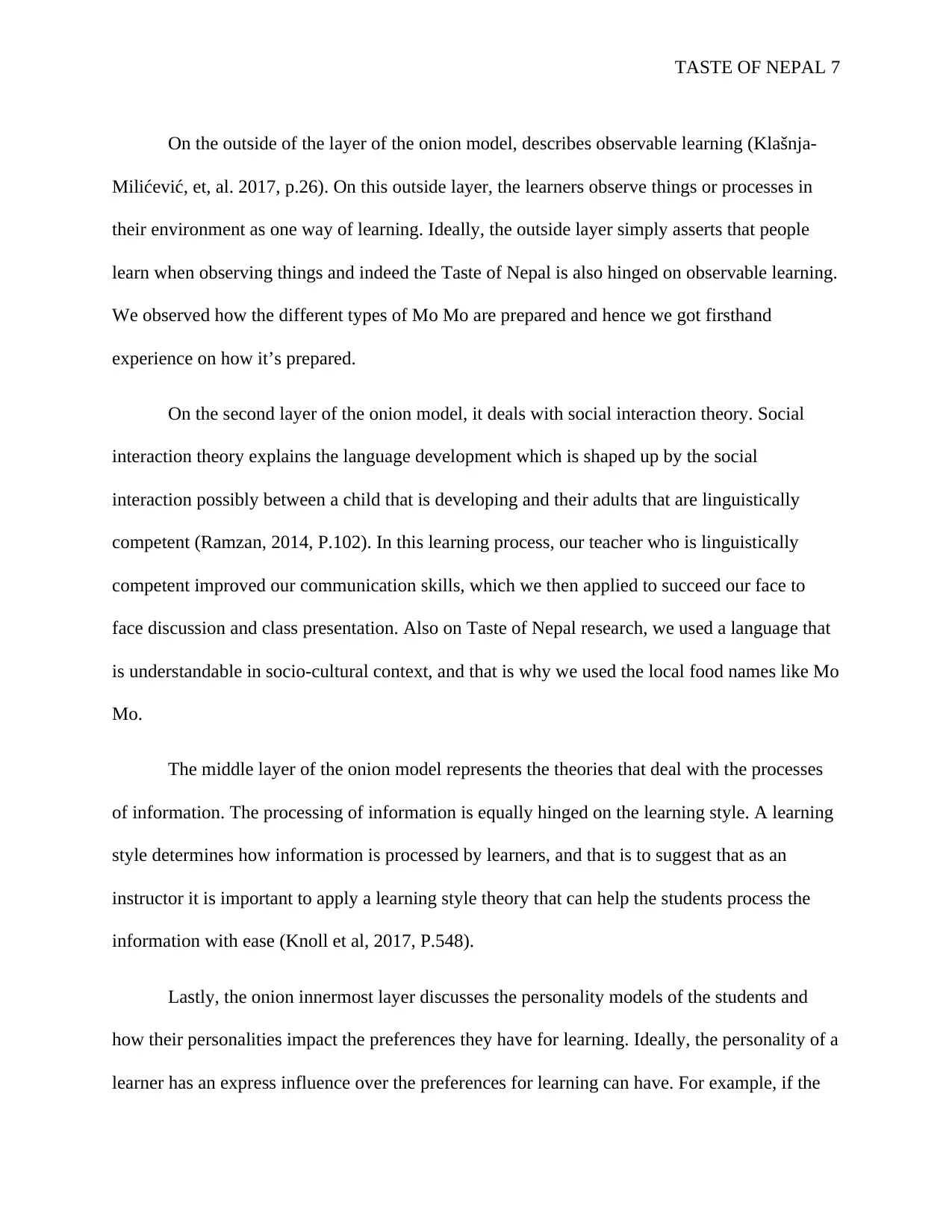
TASTE OF NEPAL 7
On the outside of the layer of the onion model, describes observable learning (Klašnja-
Milićević, et, al. 2017, p.26). On this outside layer, the learners observe things or processes in
their environment as one way of learning. Ideally, the outside layer simply asserts that people
learn when observing things and indeed the Taste of Nepal is also hinged on observable learning.
We observed how the different types of Mo Mo are prepared and hence we got firsthand
experience on how it’s prepared.
On the second layer of the onion model, it deals with social interaction theory. Social
interaction theory explains the language development which is shaped up by the social
interaction possibly between a child that is developing and their adults that are linguistically
competent (Ramzan, 2014, P.102). In this learning process, our teacher who is linguistically
competent improved our communication skills, which we then applied to succeed our face to
face discussion and class presentation. Also on Taste of Nepal research, we used a language that
is understandable in socio-cultural context, and that is why we used the local food names like Mo
Mo.
The middle layer of the onion model represents the theories that deal with the processes
of information. The processing of information is equally hinged on the learning style. A learning
style determines how information is processed by learners, and that is to suggest that as an
instructor it is important to apply a learning style theory that can help the students process the
information with ease (Knoll et al, 2017, P.548).
Lastly, the onion innermost layer discusses the personality models of the students and
how their personalities impact the preferences they have for learning. Ideally, the personality of a
learner has an express influence over the preferences for learning can have. For example, if the
On the outside of the layer of the onion model, describes observable learning (Klašnja-
Milićević, et, al. 2017, p.26). On this outside layer, the learners observe things or processes in
their environment as one way of learning. Ideally, the outside layer simply asserts that people
learn when observing things and indeed the Taste of Nepal is also hinged on observable learning.
We observed how the different types of Mo Mo are prepared and hence we got firsthand
experience on how it’s prepared.
On the second layer of the onion model, it deals with social interaction theory. Social
interaction theory explains the language development which is shaped up by the social
interaction possibly between a child that is developing and their adults that are linguistically
competent (Ramzan, 2014, P.102). In this learning process, our teacher who is linguistically
competent improved our communication skills, which we then applied to succeed our face to
face discussion and class presentation. Also on Taste of Nepal research, we used a language that
is understandable in socio-cultural context, and that is why we used the local food names like Mo
Mo.
The middle layer of the onion model represents the theories that deal with the processes
of information. The processing of information is equally hinged on the learning style. A learning
style determines how information is processed by learners, and that is to suggest that as an
instructor it is important to apply a learning style theory that can help the students process the
information with ease (Knoll et al, 2017, P.548).
Lastly, the onion innermost layer discusses the personality models of the students and
how their personalities impact the preferences they have for learning. Ideally, the personality of a
learner has an express influence over the preferences for learning can have. For example, if the
Paraphrase This Document
Need a fresh take? Get an instant paraphrase of this document with our AI Paraphraser
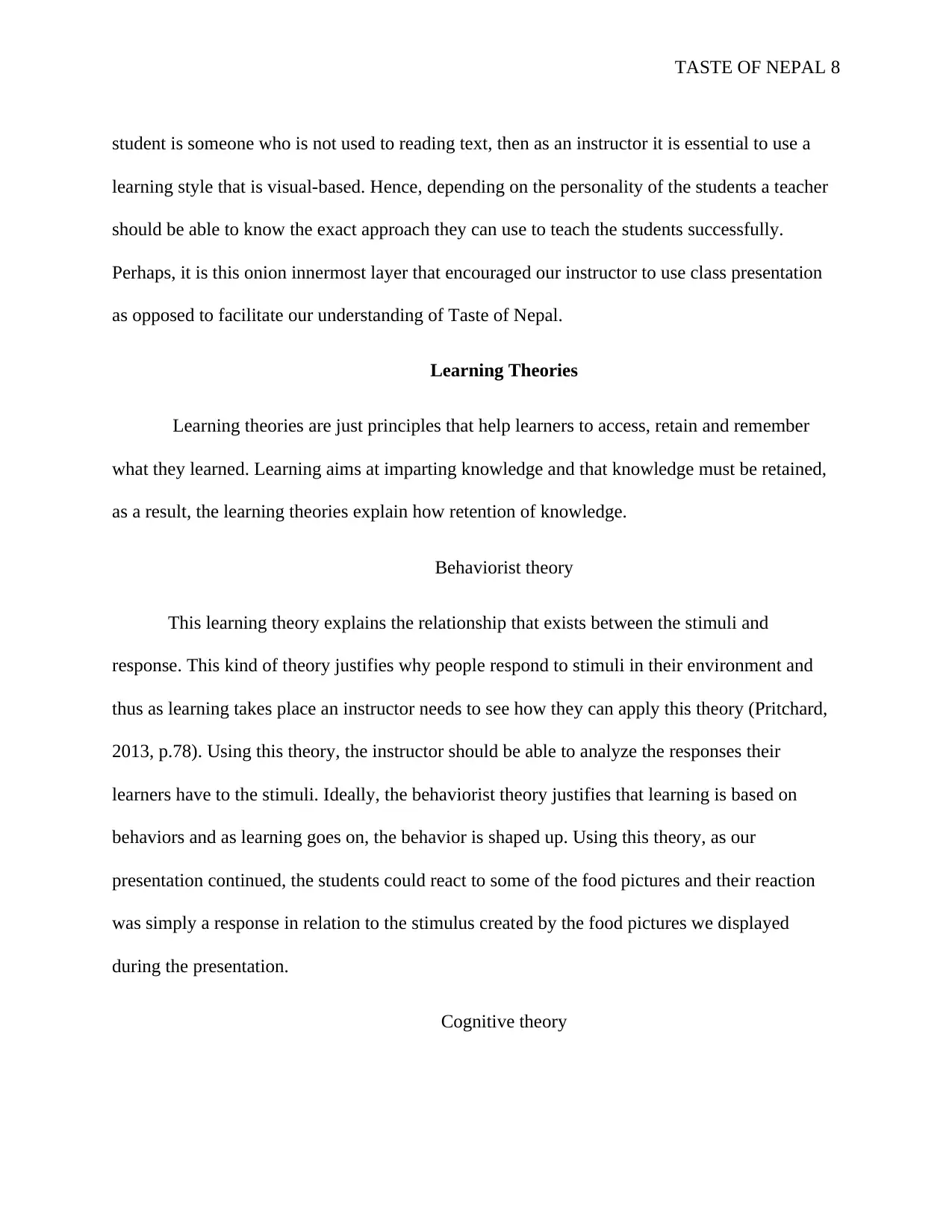
TASTE OF NEPAL 8
student is someone who is not used to reading text, then as an instructor it is essential to use a
learning style that is visual-based. Hence, depending on the personality of the students a teacher
should be able to know the exact approach they can use to teach the students successfully.
Perhaps, it is this onion innermost layer that encouraged our instructor to use class presentation
as opposed to facilitate our understanding of Taste of Nepal.
Learning Theories
Learning theories are just principles that help learners to access, retain and remember
what they learned. Learning aims at imparting knowledge and that knowledge must be retained,
as a result, the learning theories explain how retention of knowledge.
Behaviorist theory
This learning theory explains the relationship that exists between the stimuli and
response. This kind of theory justifies why people respond to stimuli in their environment and
thus as learning takes place an instructor needs to see how they can apply this theory (Pritchard,
2013, p.78). Using this theory, the instructor should be able to analyze the responses their
learners have to the stimuli. Ideally, the behaviorist theory justifies that learning is based on
behaviors and as learning goes on, the behavior is shaped up. Using this theory, as our
presentation continued, the students could react to some of the food pictures and their reaction
was simply a response in relation to the stimulus created by the food pictures we displayed
during the presentation.
Cognitive theory
student is someone who is not used to reading text, then as an instructor it is essential to use a
learning style that is visual-based. Hence, depending on the personality of the students a teacher
should be able to know the exact approach they can use to teach the students successfully.
Perhaps, it is this onion innermost layer that encouraged our instructor to use class presentation
as opposed to facilitate our understanding of Taste of Nepal.
Learning Theories
Learning theories are just principles that help learners to access, retain and remember
what they learned. Learning aims at imparting knowledge and that knowledge must be retained,
as a result, the learning theories explain how retention of knowledge.
Behaviorist theory
This learning theory explains the relationship that exists between the stimuli and
response. This kind of theory justifies why people respond to stimuli in their environment and
thus as learning takes place an instructor needs to see how they can apply this theory (Pritchard,
2013, p.78). Using this theory, the instructor should be able to analyze the responses their
learners have to the stimuli. Ideally, the behaviorist theory justifies that learning is based on
behaviors and as learning goes on, the behavior is shaped up. Using this theory, as our
presentation continued, the students could react to some of the food pictures and their reaction
was simply a response in relation to the stimulus created by the food pictures we displayed
during the presentation.
Cognitive theory
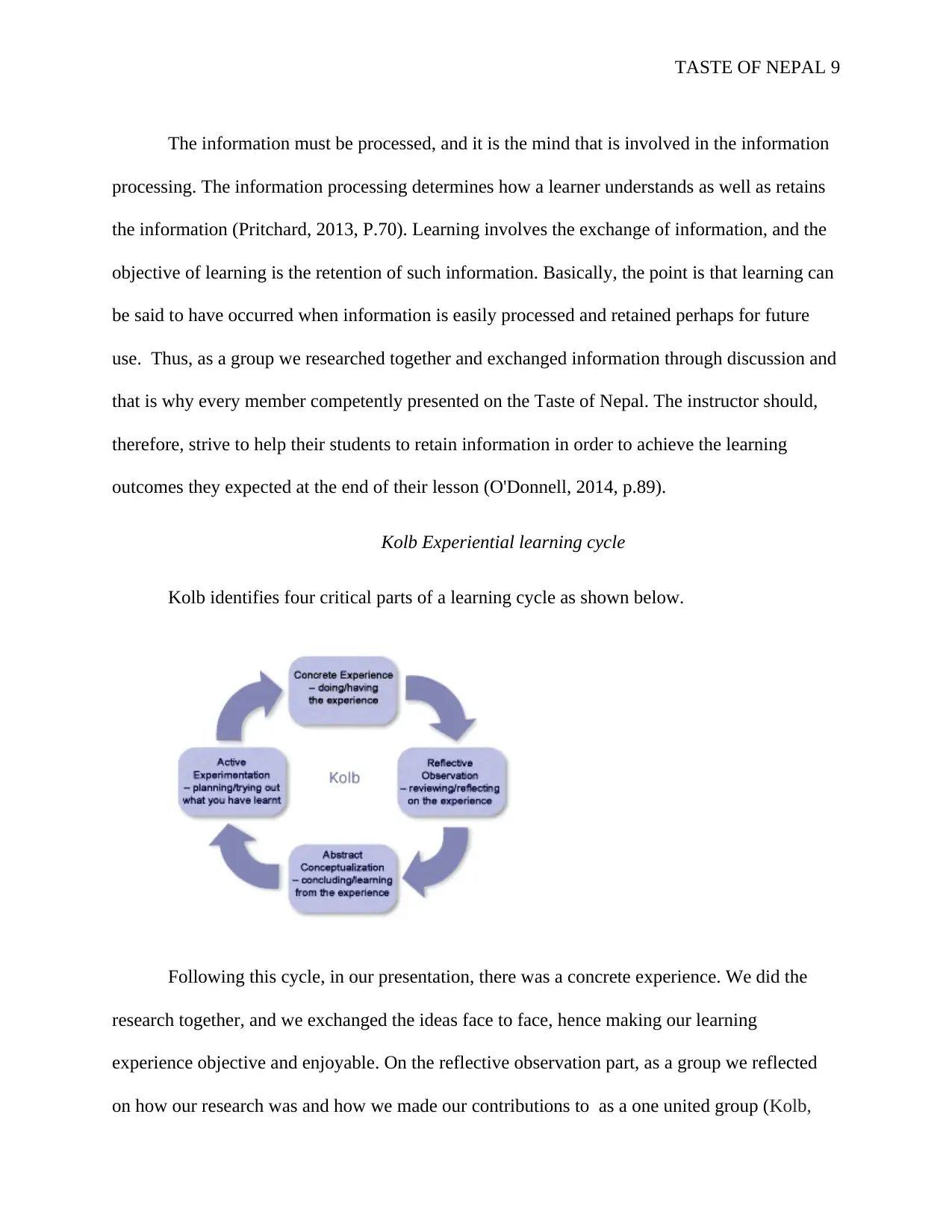
TASTE OF NEPAL 9
The information must be processed, and it is the mind that is involved in the information
processing. The information processing determines how a learner understands as well as retains
the information (Pritchard, 2013, P.70). Learning involves the exchange of information, and the
objective of learning is the retention of such information. Basically, the point is that learning can
be said to have occurred when information is easily processed and retained perhaps for future
use. Thus, as a group we researched together and exchanged information through discussion and
that is why every member competently presented on the Taste of Nepal. The instructor should,
therefore, strive to help their students to retain information in order to achieve the learning
outcomes they expected at the end of their lesson (O'Donnell, 2014, p.89).
Kolb Experiential learning cycle
Kolb identifies four critical parts of a learning cycle as shown below.
Following this cycle, in our presentation, there was a concrete experience. We did the
research together, and we exchanged the ideas face to face, hence making our learning
experience objective and enjoyable. On the reflective observation part, as a group we reflected
on how our research was and how we made our contributions to as a one united group (Kolb,
The information must be processed, and it is the mind that is involved in the information
processing. The information processing determines how a learner understands as well as retains
the information (Pritchard, 2013, P.70). Learning involves the exchange of information, and the
objective of learning is the retention of such information. Basically, the point is that learning can
be said to have occurred when information is easily processed and retained perhaps for future
use. Thus, as a group we researched together and exchanged information through discussion and
that is why every member competently presented on the Taste of Nepal. The instructor should,
therefore, strive to help their students to retain information in order to achieve the learning
outcomes they expected at the end of their lesson (O'Donnell, 2014, p.89).
Kolb Experiential learning cycle
Kolb identifies four critical parts of a learning cycle as shown below.
Following this cycle, in our presentation, there was a concrete experience. We did the
research together, and we exchanged the ideas face to face, hence making our learning
experience objective and enjoyable. On the reflective observation part, as a group we reflected
on how our research was and how we made our contributions to as a one united group (Kolb,
⊘ This is a preview!⊘
Do you want full access?
Subscribe today to unlock all pages.

Trusted by 1+ million students worldwide
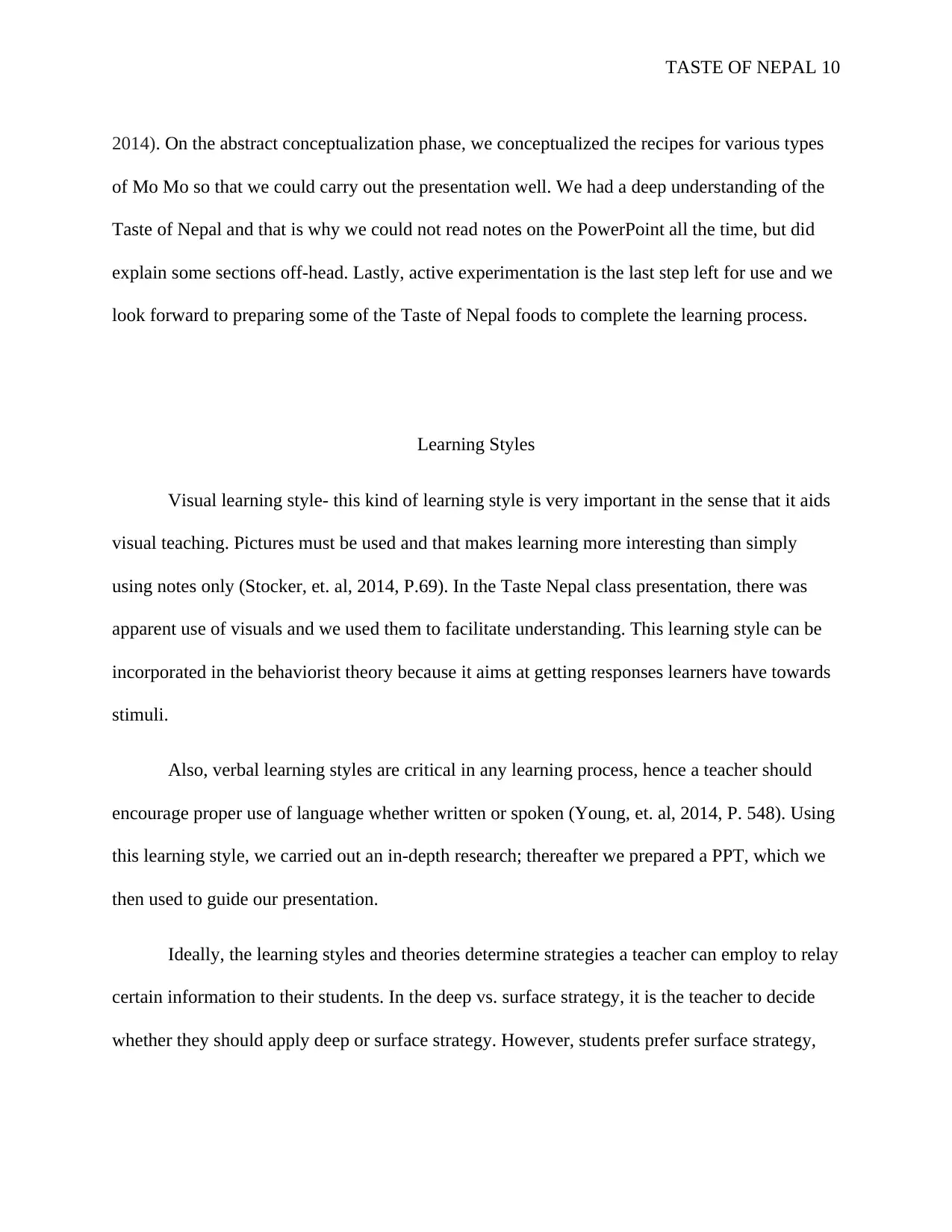
TASTE OF NEPAL 10
2014). On the abstract conceptualization phase, we conceptualized the recipes for various types
of Mo Mo so that we could carry out the presentation well. We had a deep understanding of the
Taste of Nepal and that is why we could not read notes on the PowerPoint all the time, but did
explain some sections off-head. Lastly, active experimentation is the last step left for use and we
look forward to preparing some of the Taste of Nepal foods to complete the learning process.
Learning Styles
Visual learning style- this kind of learning style is very important in the sense that it aids
visual teaching. Pictures must be used and that makes learning more interesting than simply
using notes only (Stocker, et. al, 2014, P.69). In the Taste Nepal class presentation, there was
apparent use of visuals and we used them to facilitate understanding. This learning style can be
incorporated in the behaviorist theory because it aims at getting responses learners have towards
stimuli.
Also, verbal learning styles are critical in any learning process, hence a teacher should
encourage proper use of language whether written or spoken (Young, et. al, 2014, P. 548). Using
this learning style, we carried out an in-depth research; thereafter we prepared a PPT, which we
then used to guide our presentation.
Ideally, the learning styles and theories determine strategies a teacher can employ to relay
certain information to their students. In the deep vs. surface strategy, it is the teacher to decide
whether they should apply deep or surface strategy. However, students prefer surface strategy,
2014). On the abstract conceptualization phase, we conceptualized the recipes for various types
of Mo Mo so that we could carry out the presentation well. We had a deep understanding of the
Taste of Nepal and that is why we could not read notes on the PowerPoint all the time, but did
explain some sections off-head. Lastly, active experimentation is the last step left for use and we
look forward to preparing some of the Taste of Nepal foods to complete the learning process.
Learning Styles
Visual learning style- this kind of learning style is very important in the sense that it aids
visual teaching. Pictures must be used and that makes learning more interesting than simply
using notes only (Stocker, et. al, 2014, P.69). In the Taste Nepal class presentation, there was
apparent use of visuals and we used them to facilitate understanding. This learning style can be
incorporated in the behaviorist theory because it aims at getting responses learners have towards
stimuli.
Also, verbal learning styles are critical in any learning process, hence a teacher should
encourage proper use of language whether written or spoken (Young, et. al, 2014, P. 548). Using
this learning style, we carried out an in-depth research; thereafter we prepared a PPT, which we
then used to guide our presentation.
Ideally, the learning styles and theories determine strategies a teacher can employ to relay
certain information to their students. In the deep vs. surface strategy, it is the teacher to decide
whether they should apply deep or surface strategy. However, students prefer surface strategy,
Paraphrase This Document
Need a fresh take? Get an instant paraphrase of this document with our AI Paraphraser
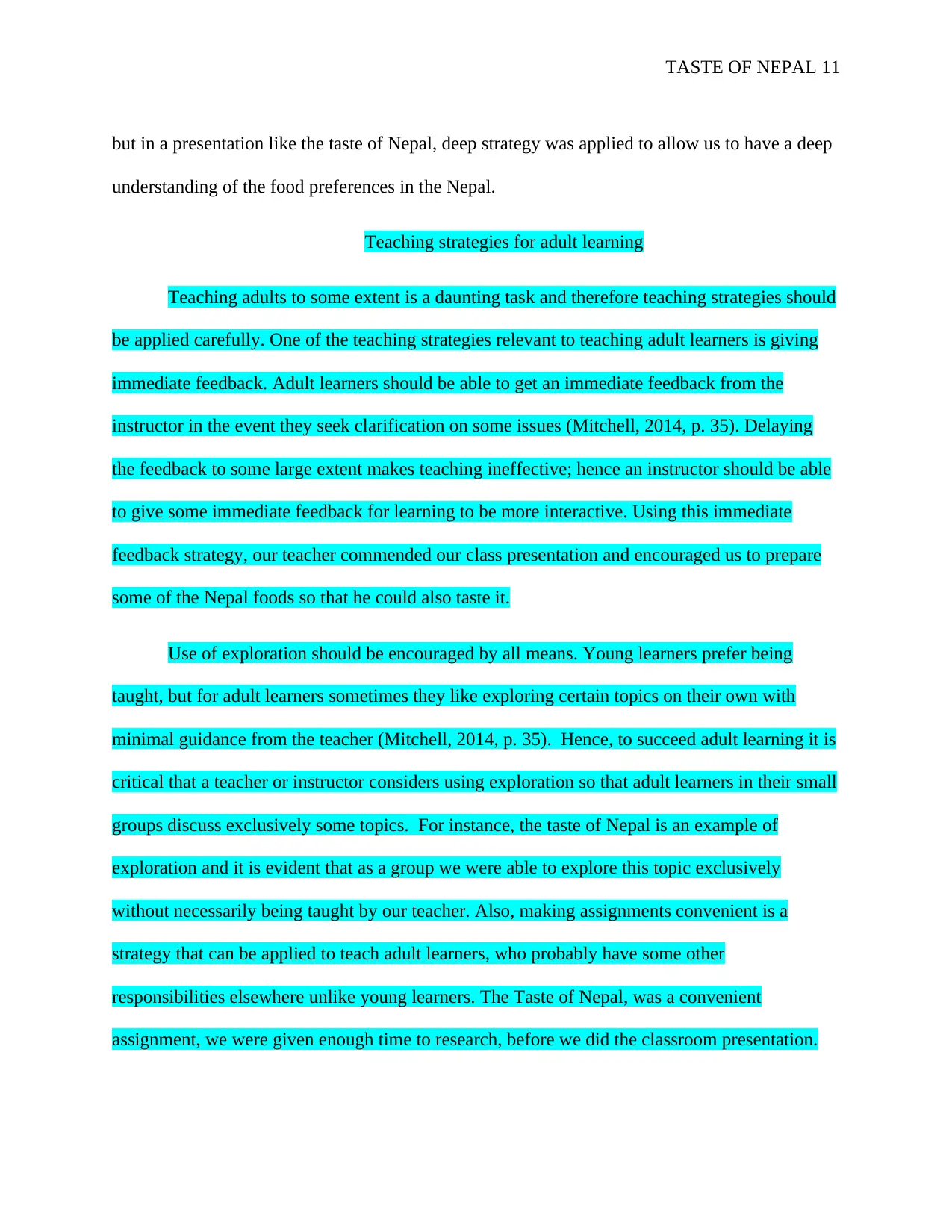
TASTE OF NEPAL 11
but in a presentation like the taste of Nepal, deep strategy was applied to allow us to have a deep
understanding of the food preferences in the Nepal.
Teaching strategies for adult learning
Teaching adults to some extent is a daunting task and therefore teaching strategies should
be applied carefully. One of the teaching strategies relevant to teaching adult learners is giving
immediate feedback. Adult learners should be able to get an immediate feedback from the
instructor in the event they seek clarification on some issues (Mitchell, 2014, p. 35). Delaying
the feedback to some large extent makes teaching ineffective; hence an instructor should be able
to give some immediate feedback for learning to be more interactive. Using this immediate
feedback strategy, our teacher commended our class presentation and encouraged us to prepare
some of the Nepal foods so that he could also taste it.
Use of exploration should be encouraged by all means. Young learners prefer being
taught, but for adult learners sometimes they like exploring certain topics on their own with
minimal guidance from the teacher (Mitchell, 2014, p. 35). Hence, to succeed adult learning it is
critical that a teacher or instructor considers using exploration so that adult learners in their small
groups discuss exclusively some topics. For instance, the taste of Nepal is an example of
exploration and it is evident that as a group we were able to explore this topic exclusively
without necessarily being taught by our teacher. Also, making assignments convenient is a
strategy that can be applied to teach adult learners, who probably have some other
responsibilities elsewhere unlike young learners. The Taste of Nepal, was a convenient
assignment, we were given enough time to research, before we did the classroom presentation.
but in a presentation like the taste of Nepal, deep strategy was applied to allow us to have a deep
understanding of the food preferences in the Nepal.
Teaching strategies for adult learning
Teaching adults to some extent is a daunting task and therefore teaching strategies should
be applied carefully. One of the teaching strategies relevant to teaching adult learners is giving
immediate feedback. Adult learners should be able to get an immediate feedback from the
instructor in the event they seek clarification on some issues (Mitchell, 2014, p. 35). Delaying
the feedback to some large extent makes teaching ineffective; hence an instructor should be able
to give some immediate feedback for learning to be more interactive. Using this immediate
feedback strategy, our teacher commended our class presentation and encouraged us to prepare
some of the Nepal foods so that he could also taste it.
Use of exploration should be encouraged by all means. Young learners prefer being
taught, but for adult learners sometimes they like exploring certain topics on their own with
minimal guidance from the teacher (Mitchell, 2014, p. 35). Hence, to succeed adult learning it is
critical that a teacher or instructor considers using exploration so that adult learners in their small
groups discuss exclusively some topics. For instance, the taste of Nepal is an example of
exploration and it is evident that as a group we were able to explore this topic exclusively
without necessarily being taught by our teacher. Also, making assignments convenient is a
strategy that can be applied to teach adult learners, who probably have some other
responsibilities elsewhere unlike young learners. The Taste of Nepal, was a convenient
assignment, we were given enough time to research, before we did the classroom presentation.
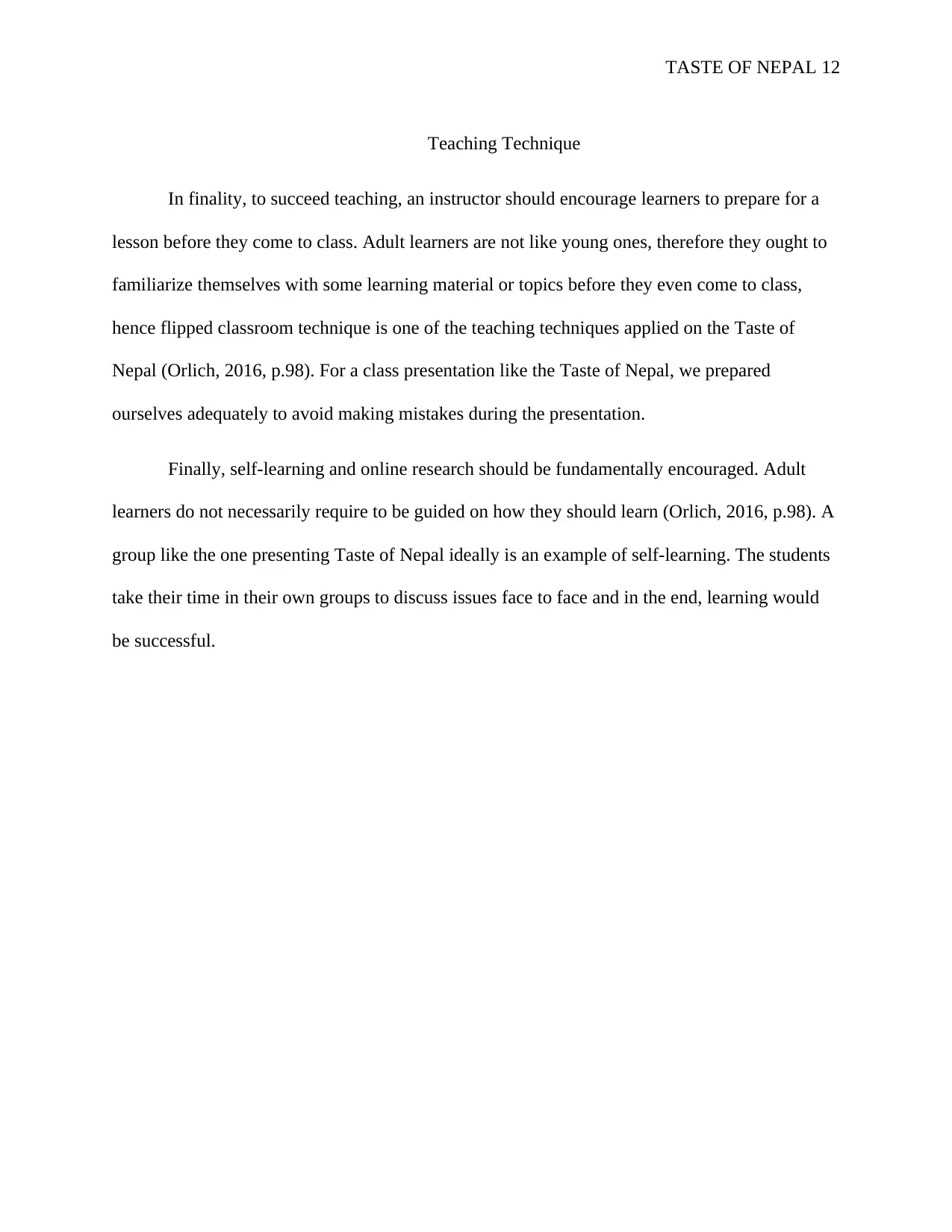
TASTE OF NEPAL 12
Teaching Technique
In finality, to succeed teaching, an instructor should encourage learners to prepare for a
lesson before they come to class. Adult learners are not like young ones, therefore they ought to
familiarize themselves with some learning material or topics before they even come to class,
hence flipped classroom technique is one of the teaching techniques applied on the Taste of
Nepal (Orlich, 2016, p.98). For a class presentation like the Taste of Nepal, we prepared
ourselves adequately to avoid making mistakes during the presentation.
Finally, self-learning and online research should be fundamentally encouraged. Adult
learners do not necessarily require to be guided on how they should learn (Orlich, 2016, p.98). A
group like the one presenting Taste of Nepal ideally is an example of self-learning. The students
take their time in their own groups to discuss issues face to face and in the end, learning would
be successful.
Teaching Technique
In finality, to succeed teaching, an instructor should encourage learners to prepare for a
lesson before they come to class. Adult learners are not like young ones, therefore they ought to
familiarize themselves with some learning material or topics before they even come to class,
hence flipped classroom technique is one of the teaching techniques applied on the Taste of
Nepal (Orlich, 2016, p.98). For a class presentation like the Taste of Nepal, we prepared
ourselves adequately to avoid making mistakes during the presentation.
Finally, self-learning and online research should be fundamentally encouraged. Adult
learners do not necessarily require to be guided on how they should learn (Orlich, 2016, p.98). A
group like the one presenting Taste of Nepal ideally is an example of self-learning. The students
take their time in their own groups to discuss issues face to face and in the end, learning would
be successful.
⊘ This is a preview!⊘
Do you want full access?
Subscribe today to unlock all pages.

Trusted by 1+ million students worldwide
1 out of 14
Related Documents
Your All-in-One AI-Powered Toolkit for Academic Success.
+13062052269
info@desklib.com
Available 24*7 on WhatsApp / Email
![[object Object]](/_next/static/media/star-bottom.7253800d.svg)
Unlock your academic potential
Copyright © 2020–2025 A2Z Services. All Rights Reserved. Developed and managed by ZUCOL.




